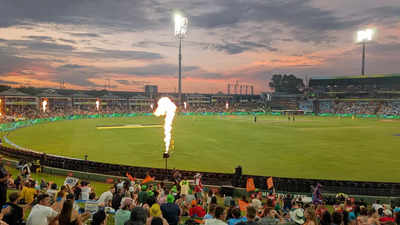TimesofIndia.com in Johannesburg:SA20 league commissioner Graeme Smith and the various ambassadors such as AB de Villiers, Jacques Kallis and Allan Donald have no hesitation in accepting that Indian Premier League (IPL) is the biggest T20 league in the world. And it is an accurate statement in a lot of metrics – viewership, fan attendance, prize money, salaries, revenues and in the intangibles such as attracting the best local and international talent.
IPL even has the capacity – and the might – to ensure that no other T20 league happens during its two month window. For those eight or so weeks, international cricket nearly grinds to a halt too. That is for another day, for another article.
Go Beyond The Boundary with our YouTube channel. SUBSCRIBE NOW!
For the purpose of this article, we look at what IPL can learn from the SA20, which concluded its third edition on Saturday.
With MI Cape Town crowned champions in front of over 22,000 fans, it was a proud moment for former South Africa captain Graeme Smith. Not so long ago, South African cricket was struggling to get fans through the turnstiles. Cricket, the third most popular sport in the country after rugby and football, has turned a leaf, induced in large parts by the franchise-based T20 competition.
The loyalty shown by the fans has even taken Smith by surprise as the St George’s Park had a lot of Orange & yellow for Joburg Super Kings and a covering of blue for MI Cape Town.
“I think fan loyalty has amazed me this year, when I’ve arrived in stadiums and seen, you know, the Orange Army in PE or yellow in Joburg and blue, that’s actually surprised me, how fast people have got behind their teams. And, you know, almost in the India style, where they’re not even cheering the opposition’s success. So that’s been amazing,” said Smith, who played for Pune Warriors India and Rajasthan Royals in the IPL, in an exclusive conversation with TimesofIndia.com.
AB de Villiers believes the timing of the SA20 could not have come at a more fitting time for South African cricket. He added that the weather plays a big role in bringing people by the thousands.
“It (SA20) came at a time when people were hungry to see quality cricket,” said De Villiers, who is an SA20 Ambassador, in an interaction with select media.
“I think South Africans love the outdoors and around December, January and February… It’s the best time, weather wise. We love our sports. The timing of this tournament is spot on as South African cricket was going through a bit of a dip. There were some structural changes in the board, now there’s a bit of consistency,” he further explained.
Even though the third edition didn’t offer many edge-of-the-seat games, crowds continued to pour in huge numbers. Not many grounds can offer what the South African venues do – grassbanks, brass bands in volume, lawn chairs, barbecues and a complete family outing.
Through the course of the playoff week during the SA20, St George’s Park in Gqeberha, Centurion and Wanderers in Johannesburg, there was a personality to the crowd that you won’t get in the IPL.
At St George’s Park, placed in beautiful Port Elizabeth, sitting along the coast, there’s an iconic band that practices twice a week and arrives in numbers to keep the fans entertained through their African music and renditions of popular songs.
They take their place on the unreserved wooden seats at one of the oldest grounds in the country and play the trumpet, the trombones, the drums and a colossal tuba.
Move to Centurion and the grassbanks become more prominent. Instead of the stands, fans – many of them families – prefer plonking themselves on the lawn chairs that are allowed inside the stadium. There is a picnic atmosphere with food, beer and about 20 barbecue pits stationed by the organisers for visitors to use the grills if needed. As thousands watched the SA20 playoffs, there were youngsters who entertained themselves by throwing the rugby ball around or playing cricket of their own.
Fans occupy the grassbanks at Centurion in Johannesburg during the SA20. (Image: TimesofIndia.com)
Interestingly, the difference in pricing between the grassbanks and the seated stands isn’t all that much. The seated stands for a playoff game were priced at R150-R190 (Rs. 750-Rs. 950) while grass embankments were priced at R120-R150 (Rs 600-Rs 750).
Not far away from the Centurion is the Wanderers. When trying to enter, there are the segregating barricades that one is accustomed to while entering stadium venues in India but what differs is the ease of entry.
After scanning the barcodes of tickets, with gates opening as early as three hours in advance on the day of the final, fans are free to buy food, drinks, dance their way through the evening with plenty of activities for the spectator – such as the brass band on entry, selfie point in front of a board bearing Sachin Tendulkar’s name and photos with people in costumes.
Fans could take selfies next to a giant Sachin Tendulkar board at the Wanderers in Johannesburg. (Image: TimesofIndia.com)
Then there are a couple of common themes across the stadiums to keep everyone entertained. It ranges from dance cams, lookalike cams, to hilarious face morphers. This is besides the massive prize money on offer to fans who take a single-handed catch.
Further, the food and beverages are modestly priced at the stadiums – a near-luxury at the IPL and even at the European, American sports facilities. A giant pizza slice was priced at R90 (~ Rs 422), a burger at R65 (~ Rs 304) or a bag of popcorn at R20 (~Rs 93).
As a result, SA20 ensures there is an atmosphere for the ardent cricket fan and something for the entire family – young or old. IPL, in this regard, has a long way to go.
